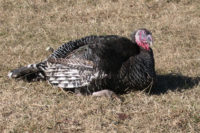Pest Management
How to spot (and swat) flies in food processing
Understand the differences among flies to improve pest management

With so many types of flies in existence, it is crucial for food processors to understand the differences among fly species so they can quickly and effectively solve any potential issues.
A perennial pest, flies comprise one of the largest and most diverse orders of insects. Knowing what to look for can help managers address problems with maximum effectiveness.
Fly size is a key factor in determining an appropriate response from a pest management perspective. Large flies usually enter food plants as incidental invaders, and small flies more commonly develop inside the plant, indicating a larger sanitation issue.
Flies can easily carry pathogens from one surface to another, making their bodies a potential contaminant source. Small fly issues that have escalated to problem status are more common in the industry than large fly issues. Getting to the source of small fly issues and correcting the problem is often a challenge to sanitation and facility operations, so quickly identifying the fly at hand can point to the specifics of its habitat and its source.
From small to large, below are the types of flies you could be dealing with, as well as what your pest professional is looking for to keep your facility rid of flies and audit ready.
Small flies
Fruit flies: Fruit flies are the most common type of small flies. Sugary, malty or vinegar-type materials like soft drink dispensers, beer taps, overripe fruit or fruit waste, trash cans, or vending machines with residues are common attractants for fruit flies. Bottling, processing or packaging lines that allow sugary materials to fall into mechanical parts can also become attractants. If the source of the fly’s attractant is not obvious, there are fruit fly traps to help control and monitor their activity, and small shallow containers with a sugary fluid can be used as basic monitors to help pinpoint a source.
The most familiar fruit fly in these conditions is a small tan- or gray-bodied fly with red eyes: Drosophila melanogaster. Another important type of fly, D. replete, is slightly larger than the others and has dark eyes instead of red ones. These dark-eyed types are associated with more advanced decomposition of organic materials in cracks, crevices, drains, etc.
Phorid flies: Phorid flies have a distinctive humped back and small head. They infest food wastes, sewage, dead animals and other damp organic materials. Phorid flies can infest resources deep underground, such as cracks and crevices where dirty water or mops continually feed organic material. There they quickly multiply in the contaminated soil surrounding broken burried drain lines. These broken drain lines under the floors of food plants are surprisingly common, and when they cause a phorid fly problem, the only solution is to jackhammer the floor to properly repair the drain and remove and replace any contaminated soil. Additionally, be sure to replace any water and wash all mops that are continually used, as these can push debris into cracks and crevices, creating a prime habitat for phorid flies.
Drain flies: Drain flies are small, fuzzy flies that look similar to moths. Unlike other types of flies, drain flies are not strong fliers and tend to spend most of their time in moist, slime-filled cracks, crevices and drains. Drain flies most commonly appear in small numbers, usually resting on walls or surfaces and only moving a few feet when disturbed. Monitor drains by placing glue boards nearby to identify the trouble spots and efficiently remediate the situation.
Small dung flies: Also a friend of dirty drains, the small dung fly—or Sphaerocerid fly—looks similar to a miniature house fly. Like the others, they are associated with moist, decaying organic materials and often found in areas such as drains or floor cracks into which organic material may have been mopped.
Large flies
Unlike small flies, large flies are usually incidental invaders in a facility. Different types of large flies indicate different root problems, so identifying them properly is critical in solving the problem.
Blow flies tend to be associated with garbage and food waste, while house flies are more often associated with manure and other damp organic materials. Cluster flies, found in the upper Midwest and Northeast, are larger and hairier than a house fly or blow fly, and are not necessarily attracted to foods or filth, but gain entry through roof fixtures or other cracks and crevices.
Large flies can find their way inside throughout winter and spring, sometimes in large numbers, and are also strongly attracted to sunny windows and light traps. If these flies are regularly found indoors during colder months, it is possible they are developing on rotting food sources that need to be identified and properly cleaned.
Taking action
Once you’ve narrowed down which fly species you’re dealing with, you can work toward a resolution for the issue. When it comes to preventing flies, small or large, the solution comes down to proper sanitation. Scheduled cleanings should occur for food processing companies roughly once a week to properly disrupt the developmental cycles for the top chronic pest species. For certain processing and packaging equipment, as well as drains, periodic physical cleaning is recommended. Chemical and probiotic cleaners can also be useful for some types of equipment, cracks, crevices and drains.
Be sure to consult your pest management professional for help keeping your facility free of flies and ready for audits.
Looking for a reprint of this article?
From high-res PDFs to custom plaques, order your copy today!









